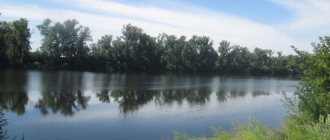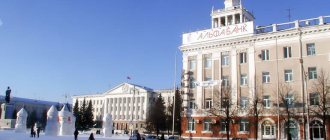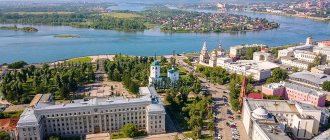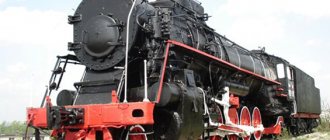Among the spurs of the Ural Mountains in the Perm region, the ancient city of Ocher has been living and developing for several centuries.
It is separated from Perm by 122 km, but this path is worth traveling to get a closer look at the rich history of the city.
Enjoy numerous attractions and see with your own eyes the Permian Park, dedicated to the prehistoric reptiles that lived in these areas many millions of years ago.
Story
Mentions of the area along the Ocher River are known long before 1596, when Tsar Fyodor Ivanovich the Blessed allowed the Bashkir peoples to live on these lands.
Russian settlers, led by Nikita Grigorievich Stroganov, began to develop this area in 1597, building the fortified Ochersky fort on the river bank.
Additional information: these uninhabited Ural territories were granted by Stroganov back in the 16th century and were passed on from generation to generation by right of inheritance.
The city of Ocher itself begins its history in 1759, when Elizaveta Petrovna gave Alexander Sergeevich Stroganov her Greatest permission to build an ironworks.
Under the leadership of the count, colossal work was carried out on cutting down forests, erecting factory buildings and installing smelting furnaces.
The production of cast iron began in 1761, and since then the Ocher metallurgical plant has ranked among the largest enterprises in Russia and Europe of that time.
Additional information: The second owner of the plant was the son of Alexander Sergeevich - Pavel Aleksandrovich Stroganov, at whose whim he was called “Citizen Ocher”.
Despite the fact that the count himself visited these lands once in his childhood, and controlled the plant remotely, his personality and biography formed the basis of two works of Russian literature (Yu. Tynyanov, “Citizen Ocher” and V. Pikul, “Count Popo - Citizen Ocher”).
The successful operation of the factory continued for more than a century and a half, until 1909, when the production of cast iron in these places ceased to be profitable. In 1911, the plant was declared unprofitable and closed.
A new round of development of the Ochersky plant began in 1913. The production of agricultural machinery and components for artillery guns was opened in its buildings.
In the 1930s, the production of oil refining equipment began on the basis of the plant’s facilities, and during the Great Patriotic War - 120 mm min.
Due to the expansion of production and the assignment of city status in 1950, the population also increased.
To meet the needs of the residents, agriculture began to actively develop, a bread and food processing plant and a dairy factory appeared. A lumber production plant opened.
Now the city has a well-developed infrastructure, there are kindergartens, schools, and hospitals. The population of modern Ocher is 14,000 people.
City code 617140.
Ochersky Pond
Plunging into the city's past, we set off to meet its present. And the first thing we met was the city pond.
Although not quite so - on the way from the museum to the pond we passed a huge number of historical buildings of the century before last, as well as Pavlovskaya Alley - a small piece of road framed by trees and benches. Initially, the object was named Date Alley, but later it was renamed in honor of Pavel Stroganov.
Ochersky Pond is one of the most popular attractions of the city. It appeared, like most man-made reservoirs in the Urals, as a result of the construction of a factory dam.
Tourists are attracted here not only by the beauty of this place - we must admit that even in winter the reservoir looks quite impressive - but also by the unusualness of its design. Right in the water, not far from the dam, there are three pedestals, on each of which there is a monument. These monuments are a direct gateway to nostalgia for the USSR.
In the warm season, structures partially hidden by water look even more interesting, but their winter views can also impress.
Coordinates: 57.88788,54.673139
origin of name
The city got its name from the river flowing here. There are two versions of this name, unusual for Russian lands.
In ancient times, the river was the border of the possessions of the ancient Bashkir tribe Geine. In the Tatar language, the word “otcher” means a line, a border, a limit.
Another version says that the name came from the Komi-Permyak dialect, in which the word “osh” meant “bear”, and “cher” - “stream, water stream”.
Several centuries ago, the local forests were indeed rich in this ferocious predator, and its image still adorns the city’s coat of arms.
How to get to Ocher?
From Perm, take the highway to Izhevsk, Kazan, Moscow and drive along it until the turn to Ocher. The distance from Perm is 110 km, from Yekaterinburg – 470 km. During this trip, you should definitely go to the man-made Kopan Canal.
Sources:
Wikipedia Ocher is a historical factory town. – Perm, 2009. Zoning scheme for the territory of the Ochersky urban settlement Chagin G.N. Historical knowledge of the peoples of the Urals in the 19th – early 21st centuries. – Ekaterinburg, 2011. Encyclopedia Perm region
Pavel Raspopov
UraloVed.ru
Where to walk and what to see in Ocher
It is pleasant to be in the city at any time of the year, and walking along its streets brings a lot of pleasure to tourists and townspeople.
Permian period park
More than half a century ago, in 1949, near the nearby village of Ezhovo, a geological expedition led by P. Chudinov discovered unique remains of dinosaurs from the prehistoric period.
Most of the skeletons are almost completely preserved. Many lizards were previously unknown to science, and some species of reptiles and amphibians were named after Chudinov.
Additional information: individual bones and skeletons taken from the excavation site joined the collections of many paleontological museums in the country and around the world. You can see the “Ocher lizards” at the Paleontological Museum in Perm, the Geological Institute of the Russian Academy of Sciences, they are even in the USA in Chicago and Germany.
The park of the Permian period appeared in Ocher on the 250th anniversary of the city and is located in the park behind the local history museum.
Here are small metal copies of Permian lizards with information signs next to them.
All exhibits were made by craftsmen at a local forge. Here you can “meet” Ivanthosaurus, Anplosuchus, Estemmenosuchus Mirabilis and many others.
The park is intended for family recreation: you can take photos with almost all the exhibits, animators work with kids, and there is a children's playground. Parents with children come here on weekends from all over the area.
Dovecote
Next to the path running along the Permian period park there is a small dovecote with rare bird species. She is looked after by park rangers. Dozens of pigeons soar high and delight passers-by with their grace.
Horse yard
Horse and wildlife lovers will be interested in visiting the Horse Yard, located on Ulyanovskaya Street, 152A in the village of Vereshchagino.
Here you can book a horseback ride in nature, a photo session with horses, and also visit the petting zoo.
You can find a lot of positive reviews about this place on the Internet. Horseback riding will cost 100 rubles, and a walk through the forest will cost 500.
Sundial in Ocher
An interesting decorative object is located at house 23 on Revolutionary Street. The sundial was produced at a local factory according to the design of engineers N.I. Maltsev and P.A. Vologodin in 1885.
On an antique pedestal stands a cast-iron bowl with a dial and a triangular-shaped pointer located on it.
This is the only clock of this kind in the Perm region. If you use them correctly, it is possible to determine the time very accurately. Previously, they used them to check their pocket watches. In 1967, an elegant cast fence appeared around the clock.
Victory Park
The renovated Victory Park is a pleasant sight for the eye, which can be visited near house 53 on the street. Lenin. Its size is more reminiscent of a square.
Visitors are greeted by an alley with arches in the shape of stars, followed by the inscription “Victory”; here you can relax on benches, the ends of which are also decorated with stars.
Square of victory
There is probably Victory Square in every Russian city. Ocher was no exception. It is located on Lenin Street near building 56.
There is a stone memorial, reached by wide steps. In the center of the monument, which resembles a waving flag in shape, there is a star-shaped depression. In the center of the recess is the Order of the Red Banner, and on the side are the numbers 1941-1945.
Attractions
Sights of Ocher Mount Kokuy
The Kokuy locality of the Permian flora (Mount Kokuy) is located within the city of Ocher on the right bank of the river. Wow. Finds of petrified trees were discovered during the expansion of the road in the 80s of the 20th century. Probably, an ancient river flowed here, in the muddy sediments of which fragments of trees, bushes, and leaves were stuck. Later global geological changes led to the rise of land and the replacement of organic plant matter with minerals. As a result of all the metamorphoses, the “petrified forest” of the Permian period is clearly visible on the outcrops of the mountain. Most of the finds relate to the first coniferous trees on earth - Walchias. They were up to 10 m in height and up to 20-40 cm in girth. In addition to Walchias, there are fragments of horsetail and fern plants that reached significant sizes.
Sundial
Address: Ocher, near the house on the street. Revolutionary, 20
Cultural monument of federal significance,
The Ocher sundial is the only cast iron clock in the Urals. They were installed in 1885 by mechanical engineer Nikolai Ivanovich Maltsev according to the design of mining engineer Pyotr Aleksandrovich Vologdin. The clock shows local solar time. The clock was cast at the Ocher ironworks, the pedestal is made in the style of classicism. The fence for the sundial was made at the Ochersky Machine Plant in the summer of 1967 according to the sketches of design engineer A.V. Tetenova.
Ochersky Pond
Previously, in the 18th and 19th centuries, the Ochersky plant worked using the power of falling water accumulated in the pond. Ochersky Pond was created in 1759 - 1760. It is the second in area in the region: the greatest width is 1200 m, length is 7 km, depth is up to 12 m, area is 535 hectares. The following rivers flow into the pond: Luzhkova, Travinskaya, Chernaya and Berezovka. At their confluence, bays were formed. The shoreline of the pond has a highly indented appearance, a place of recreation and fishing for townspeople. The pond contains: pike, carp, bream and perch, pike perch, ide, roach. During their migrations, ducks and swans rest on the pond, and herons rest in Berezovsky Bay.
Near the left bank there is a picturesque artificially created island. Almost the entire territory of the island is occupied by forest (pine and spruce forests). Coastal waters are attractive for fishing.
Ochersky Pond Dam
Construction of the dam for the Ochersky plant began in 1759 by decree of Empress Elizabeth Petrovna dated June 7, 1759 on a non-residential tract. The dam was built 260 fathoms long, 17 fathoms wide at the base, and 12 fathoms at the top. At that time, the dam was one of the largest hydraulic structures in the Urals. On July 17, 1961, the Ochersky plant produced its first product - critical iron.
Pavlovsk birch alley
In 1883, schoolchildren under the leadership of Alexey Timofeevich Golubev, a teacher and employee of the patrimonial board, laid out a birch alley on the dam. Birch alley on the dam of the Ochersky Pond is a favorite place for walks of the Ochers; people call it “the alley of dates.”
In 2009, in honor of the 250th anniversary of the founding of Ocher, a memorial sign was erected at the beginning of the alley to the founders and owners of the Ocher plant, the Stroganovs, and the alley itself was named “Pavlovskaya” in honor of Pavel Stroganov.
Kopan
“Kopan” or “Prokop” is a man-made canal connecting the upper reaches of the Cheptsy River and the Kulichikha River (a tributary of the Ocher River). Dug according to the project of a member of the Verkh-Ochersky district board, technician I.F. Bushuev in 1813-1814. The length of the canal is about 1.5 kilometers, depth - from 5 to 40 meters, width - from 6 to 100 meters. The project stipulated that the creation of the canal would increase the filling (water content) of the Ocher River, and, therefore, the Ochersky Pond. Increasing the hydraulic power of the pond will, in turn, ensure the uninterrupted operation of the Ocher ironworks, which uses the force of falling water in the slots of the dam to rotate the wheels that drive the hammers in the workshops.
The project did not live up to expectations. Water flowed from Cheptsa to Kulichikha, but the water content of the Ocher River increased slightly due to the low water content of Cheptsa in its upper reaches. The canal is most filled with water during snowmelt and after heavy rains. In dry times, the water content of the canal is minimal.
Small rapids and waterfalls formed by ledges at the bottom of the canal give it its originality and attractiveness as a tourist attraction.
Ochersky Museum of Local Lore named after A.V. Netsvetaeva (Former office of the Ochersky plant)
Address: Ocher, st. Lenina, 34
Monument of urban planning and architecture of regional significance
The building was built in 1840 - 1843. designed by serf architect Andrei Mayorov. The building housed the board of directors of the Ochersky ironworks and the Ochersky mining district of the Counts Stroganovs
In terms of style, the office building is a typical monument of Russian provincial classicism. In 1883, a garden with a greenhouse was laid out next to the office. From 1919 to 1999 the building housed a school, and since 1999, the Ochersky Museum of Local Lore. A.V. Netsvetaeva.
The museum has 8 exhibition halls and exhibition halls. A variety of museum exhibits introduce visitors to the history, culture and nature of the Ochersky district.
Children's park of the Permian period
In 2009, a children's park of the Permian period was opened on the museum grounds, where sculptures and information about the Ocher animal lizards coexist with attractions. The park is a favorite vacation spot for Ocher children.
Michael the Archangel Church
Address: Ocher, st. Lenina, 32
Monument of urban planning and architecture of regional significance
The temple was built in 1830 - 1840. The Ocherskaya Mikhailo-Arkhangelskaya Church was built in the Italian style according to the design of the architect Grammatchikov, a student of Voronikhin, with money from S.V. Stroganova. In 1884-1886 A cast-iron fence was erected around the church in honor of the 25th anniversary of the abolition of serfdom.
The entrance gate to the Archangel Michael Church was made in the summer of 1887 by masters Lev and Fyodor Sholopov and Alexey Yakovlevich Moshchenikov. The gates are cut from a “plank” sheet of iron by hand.
In 1895, an iron staircase was made to the upper church - St. Nicholas the Wonderworker. In 1930, the dome and bell tower of the church were broken, the building was transferred to the club of the Ochersky Machine-Building Plant. In 1994, the building was again handed over to the believers, now it is being restored, without stopping services.
Old Believers Church
Address: st. Revolutionary, 34
Monument of urban planning and architecture of regional significance
The building was built at the end of the 19th century and was bought by merchants-Old Believers for a church instead of a burnt wooden church. The Old Believer Church functioned here until 1937. When the church was closed, the building housed a blacksmith shop, then the Rembyttekhnika workshops. On November 13, 1994, His Holiness Alimpiy, Metropolitan of Moscow and All Rus', consecrated the Ocher Old Believer Church in the name of the Dormition of the Blessed Virgin Mary.”
ocher.permarea.ru
Copan Canal
But the canal is already outside Ocher – about thirty kilometers away. Before it, the road surface can also hardly be called ideal, although in the summer, especially after rains, it becomes even more difficult to pass.
The name of the channel comes from the word “dig”. This man-made canal connects the Chepets River with the Ocher River. It was needed to solve problems with the lack of water supplies in the Ochersky factory pond . The water that set factory mechanisms in motion in the 18th–19th centuries was sometimes not enough.
To replenish the volume of water in the Ochersky Pond, this grandiose canal was dug. Construction of the canal lasted two years - in 1813-1814.
The depth of the canal reaches 40 meters, the width is up to 100 meters, and the length is more than one kilometer. The volume of excavated soil, according to experts, amounted to more than 400 thousand cubic meters. And this, let me remind you, was done by the hands of serfs, without any equipment!
But, as it turned out, all this work was in vain. The power of the Cheptsa River turned out to be insufficient to even appreciably replenish the water reserves of the factory pond in Ocher...
You can see this man-made monument from above, or you can go down and look from a completely different angle. Metal steps lead to the bottom of the canal, however, partially hidden under the snow, they seemed unsafe to us, so we did not take any risks.
But even the upper angles are enough to feel the full scale of the work invested here - the canal looks so huge that the brain refuses to accept the fact that it was dug by hand.
Coordinates: 57.898118, 54.345501
Key "Student"
Stuffed to the brim with impressions, we loaded into the car and headed back to Ocher.
It was already getting close to evening, but on the way back we still decided to visit another small city attraction - a spring called “Student”.
The territory of the spring has been landscaped - there is a small house enclosing a spring, a staircase and an arch sign indicating the place.
And from here we went straight to the hotel to relax before a new day filled with information and impressions.
Mount Kokuy
Ocher is famous not only for prehistoric lizards, but also for prehistoric plants. As you know, the Ural Sea used to splash on the territory of the Perm Territory, which left behind many historical souvenirs.
There are especially many of them on Mount Kokuy . This museum of plant antiquities was discovered by accident - during the construction of the road to the new district of Ocher, a hill was excavated, in the cutting of which many petrified trees and remains of prehistoric animals were found.
We were assured that the relics can still be seen in the cut of the mountain. Of course, we couldn’t miss the opportunity to take away such an amazing souvenir as a souvenir.
Some members of our team were determined to find a bone or at least a tooth of a prehistoric animal, but alas, we were able to find only fragments of petrified trees. Although these finds struck us to the core.
Mount Kokuy is located between two microdistricts of the city, so getting to it is not so difficult. However, now (we don’t know if this is always like this in winter, or if we were just “lucky”) the road to it is covered with snow mounds, and the path turned out to be quite bumpy. But this place is definitely worth a visit!
Coordinates: 57.875326, 54.731054










